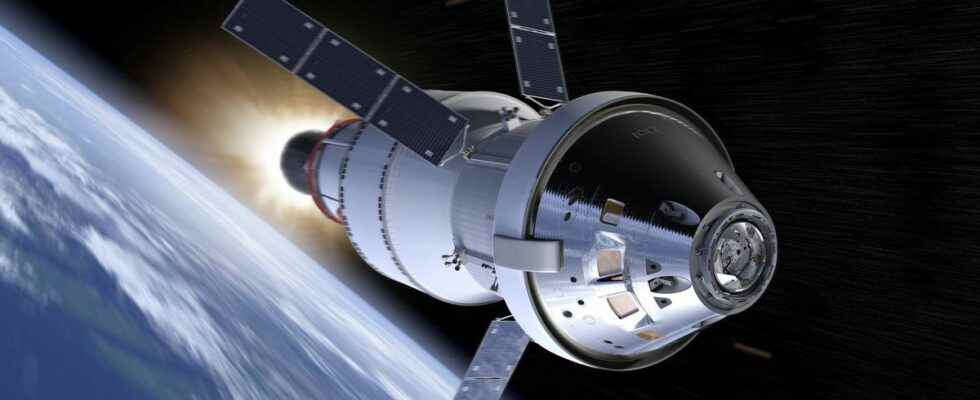An illustration of the Orion spacecraft leaving Earth. © Nasa
The American space agency concluded its Artemis I mission brilliantly by managing to bring the Orion spacecraft back to Earth on Sunday, December 11, 2022. Broadcast live, this return to the fold was also an opportunity for NASA to test an unprecedented maneuver to enter the atmosphere, and even beat a speed record.
Carried ashore by theUSS Portland of the United States Navy, the space capsule is now in the care of NASA in San Diego. There, researchers take the algae, seeds and mushrooms on board to study the effects of space radiation on these organisms with a view to sending humans to the Moon and Mars in the coming years. Orion will then be sent back to its starting point, the Kennedy Space Center in Florida.
The Orion ship leaves theUSS Portland. © Nasa
Equipped with no less than 16 cameras that can film up to 4K and take unique views of 12 million pixels (4000 x 3000 px), the capsule has taken many photos, the most sumptuous of which are dizzying. We have compiled the best ones for you.
The best photos of the Artemis mission
This sublime photo of the Earth was taken on the first day of Orion’s journey, November 16, 2022, as it moved away from our large blue marble to enter orbit around our natural satellite. To capture this view, the device used one of the cameras placed on its solar-paneled wings.
The day after the massive SLS rocket lifts off, propelling Orion into space, the ship’s navigation camera in turn produces a view of Earth, this time in black and white. The advantages of cameras of this type are better accuracy and greater sensitivity to light than color sensors.
After six days of travel, Orion arrived close to the Moon and delivered this photo to us. The dark spot on the left is the Eastern Sea, one of the most important lunar “seas”, in fact a huge crater surrounded by mountains. It is bounded by two mountain ranges, the first with a diameter of 700 km and the second 900 km. Like all the “selfie” images of Orion, it was once again one of the cameras placed on its solar panels which was at work.
During its first lunar flyby, on November 21, 2022, the space capsule photographed the craters very closely thanks, once again, to its black and white navigation camera. It is also the closest shot of the lunar ground taken by a spacecraft since the Apollo missions in the 1970s.
On the twentieth day of travel, just before returning to Earth, Orion made a final flyby a few tens of kilometers above the lunar surface. The opportunity to capture this very beautiful image.
This photo was taken on the same day as the previous one, December 5, 2022. On this day, Orion performed its last major maneuver of burn. Thanks to its propulsion system, the spacecraft exploited the lunar gravity to rush towards our planet at 1070 km/h.
Another image produced during the last lunar flyby, on the twentieth day of the mission. We can again see the surface of the satellite very closely, with a few craters. Like all the others, these cavities are the result of collisions with the many asteroids that wander through our solar system, many dating from the “late bombardment”.
Let’s go back a bit, this time with a very nice image of the Earth-Moon system captured on the thirteenth day of Orion’s journey. That day, the NASA shuttle broke a record by moving more than 434,000 km away from us, where no human transport vessel had gone before. This is almost 34,000 km more than the former record holders: the astronauts of the Apollo 13 mission in 1970, who had almost lost their lives there following the explosion of an oxygen reserve in the service module.
Let’s go back even further, to the sixth day of the Artemis I mission. This photo reveals a part of the Moon that is the source of many fantasies. Produced using Orion’s navigation camera, it reveals a portion of the hidden face of our natural satellite. Indeed, the Moon always shows us the same side, because its rotation on itself takes as much time as a rotation of our planet. This phenomenon, called synchronous rotation, is due to the tidal forces of the Earth-Moon system.
Let’s end this selection with a magnificent family portrait showing the Moon in the foreground and a sunlit crescent of the Earth, visible just below. To hope to reproduce such a cliché, we will certainly have to wait for NASA’s next Artemis II mission, which aims to send astronauts around our satellite by 2024.

